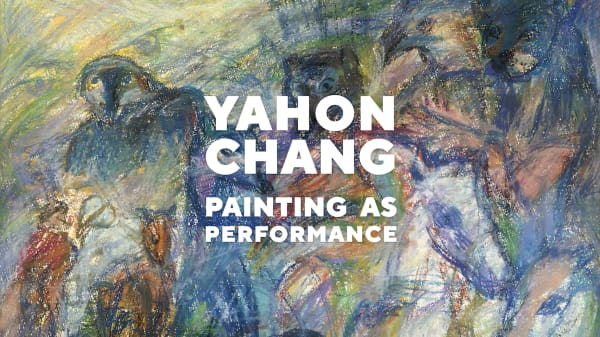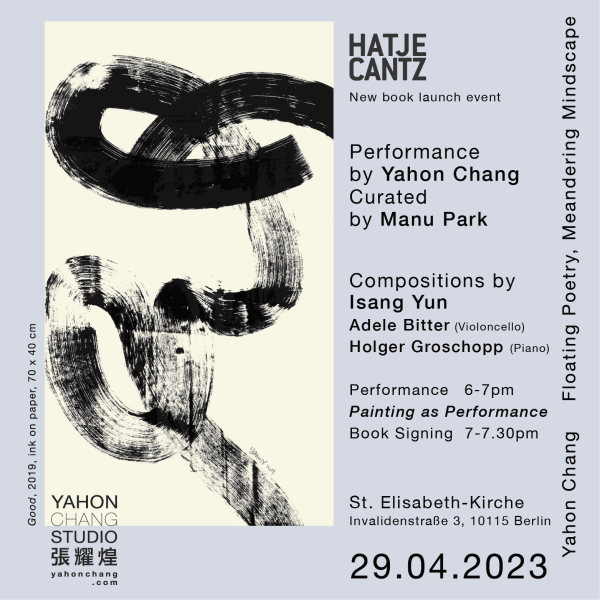b. 1948 in Shuili, Nantou County, Taiwan, lives and works in Taiwan.
In his paintings the Taiwanese artist Yahon Chang brings together traditional Chinese ink-wash painting and Western forms of artistic expression to produce a synthesis of East and West. Typically standing on large sheets of linen cloth or xuan paper and wielding a brush almost as long as he is tall, Chang creates works imbued with performative energy and characterized by large, sweeping brushstrokes. Drawing on Chinese literati and Zen (Chan) Buddhist traditions, the artist understands painting as an activity that connects body and mind. His entire body functions as an axis for these expressive paintings and is influenced by his training in calligraphy.
In 2022, Hatje Cantz will publish Yahon Chang: Painting as Performance. Edited by Dr. Britta Erickson this scholarly monograph comprehensively documents Chang’s oeuvre through authoritative texts by international art historians, curators and critics.
Excerpts from Yahon Chang: Painting as Performance:
Yahon Chang recently completed public performances in Performa 19 in New York (2019), at Palazzo Strozzi in Florence (2019), and at Outset’s artist-in-residence in London responding to a space designed by spatial practitioners Cooking Sections (2019). Major solo exhibitions include Poetry of the Flow curated by Maria Rus Bojan at Manifesta 12 in Palermo, Italy (2018), The Question of Beings at the Museum of Contemporary Art of Rome (2016) and an official collateral program of the 56th Venice Biennale (2015), the Kunsthalle Faust, Hannover, Germany (2014), the Kunstforum Markert, Hamburg, Germany (2013), the Today Art Museum, Beijing, China (2013), the China Art Academy Museum, Hangzhou, China (2012), the Ueno Royal Museum, Tokyo, Japan (2012), the Busan Museum of Art, Busan, Korea (2011), the MOCA Taipei (2011), the Taipei Fine Arts Museum (2008), the National Museum of History, Taipei (2005), the National Art Museum of China, Beijing (2005) and the Shanghai Art Museum (2000), among others. His artworks are included in the permanent collections of Shanghai Art Museum, Shanghai, China, the Busan Museum of Art, Busan, Korea, the Piervittorio Leopardi and Lidia Berlingeri Collection, Rome, Italy and the Fondation INK Collection, Geneva, Switzerland.
-

Events | "Floating Poetry, Meandering Mindscape" Solo Painting Performance by Yahon Chang
April 28, 2023Floati ng Poetry, Meandering Mindscape Solo Painting Performance by Yahon Chang Location: St. Elisabeth-Kirche, Invalidenstr. 3, 10115, Berlin, Germany Performance Date: Saturday April 29, 2023...Read more -

Artist News | Yahon Chang: Ode to Life
A monumental painting performance May 21, 2022In his paintings the Taiwanese artist Yahon Chang brings (b. 1948) together traditional Chinese ink-wash painting and Western forms of artistic expression to produce a...Read more
-

Yahon Chang: Panting as Performance
May 21, 2022“While Yahon Chang sought formal education in Chinese brush-and-ink painting and has throughout his life found inspiration in the works of a panoply of historical...Read more -

Yahon Chang: Ode to Life
A monumental painting performance May 21, 2022on March 17th, INKstudio with Yahon Chang Studio organized a monumental “painting as performance,” Ode to Life , in the newly opened Center for Art...Read more




